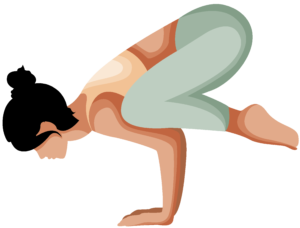Crane/Crow (Bakasana)
Pose Overview
| Common Name | Crane, Crow |
| Traditional Sanskrit Name | Bakasana |
| Sanskrit Name Pronunciation | bah-kah-SAH-nah |
| Pose Difficulty | Intermediate |
| Drishti
Drishti is the gaze or visual focus point during yoga poses.
Learn more about Drishti |
Straight ahead, slightly downward |
Crane, or Bakasana in Sanskrit, is an arm-balancing yoga pose that is said to be beneficial for strengthening the arms, wrists, and core. The name of the pose comes from the fact that it resembles a crane, with the body balanced on the arms and hands. The pose is said to be helpful for increasing upper body strength, improving balance and focus, and for promoting a sense of inner calm. It is also said to be beneficial for relieving stress and anxiety.
Benefits of Crane, Crow
Strengthens the arms, wrists, and core Improves balance and stability Opens the hips and shoulders Stimulates the abdominal organs Can help relieve stress and anxiety
How to Enter Crane, Crow
Begin in a kneeling position with your hands flat on the floor about shoulder-width apart. Bring your knees to your triceps, resting them on the back of your upper arms. Shift your weight forward and lift your feet off the floor. Keep your gaze forward and engage your core to maintain balance.
How to Exit Crane, Crow
Slowly lower your feet to the floor and release your knees from your arms. Take a few moments to rest in Child's Pose before continuing with your practice.
Common Crane, Crow Modifications & Variations
To make the pose more accessible, start by practicing with your feet on a block or other prop. To increase the challenge, try lifting one foot off the floor at a time.
Common Mistakes with Crane, Crow
Placing your hands too far apart or too close together Not engaging your core and relying solely on your arms for support Rounding your lower back
Safety Guidance
Be mindful of any wrist or arm injuries before practicing this pose. It is important to build up the strength in your arms, wrists, and core before attempting to hold the pose for an extended period of time. Do not force your body into the pose, progress gradually.

